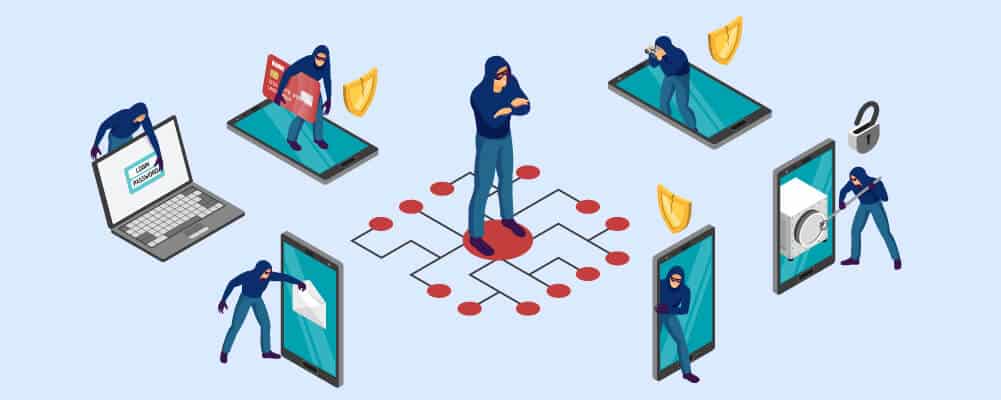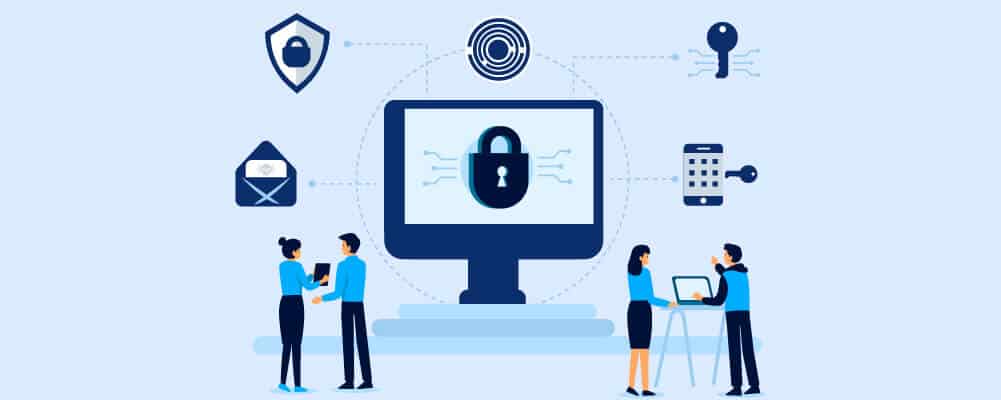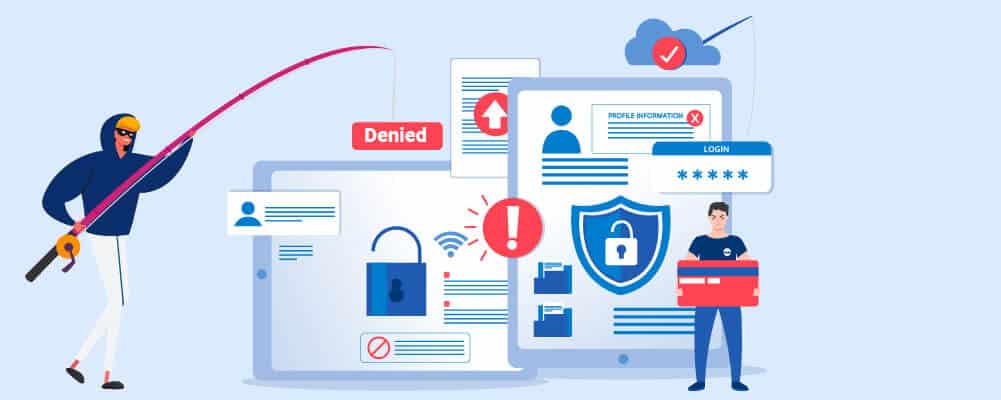Cyber threats are a constant concern that businesses have to actively think about. This is because new technologies and growing cyber awareness has created a breeding ground for new and imaginative ways for cyber attackers to tear down our fortresses.
As former Cisco CEO John Chambers once famously said, “There are two types of companies: those who have been hacked, and those who don’t yet know they have been hacked.”
This statement wasn’t created to scare businesses but to reinforce the need for active cyber security.
Today we are going to explain exactly what a cyber security threat is and the most common forms that they take. With this information, you can tighten up your own defenses and prepare for any threats that come your way.
What is a Cyber Security Threat?

Cyber security itself is often a complex term to define. In 2014, many analytical philosophers disagreed with leading definitions because they were constantly left open for interpretation. This is why many people trying to begin their cyber awareness journey were often left confused and uninformed.
For example, in 2012, the Director of Research at the National Security Agency in the United States defined cyber security as “fundamentally about an adversarial engagement. Humans must defend machines that are attacked by other humans using machines.”
In 2014, Dan Craigen, Nadia Diakun-Thibault, and Randy Purse proposed a new definition, and this one manages to broaden the scope of cyber landscapes and their properties. They finally settled on:
“Cybersecurity is the organization and collection of resources, processes, and structures used to protect cyberspace and cyberspace-enabled systems from occurrences that misalign de jure from de facto property rights.”
This therefore allowed non-smart technologies like pencil sharpeners and soap dispensers to be removed from the equation.
To jump on the back of previous researchers, cyber security protects cyberspaces (like websites) and cyberspace systems (like computers) from thieves, breakages, and unauthorized viewing.
Now you know what cyber security is, it’s time to define cyber security threats. 10 Crucial Cyber Security Tips for Small Businesses in 2022
Your doctor will probably start you on a low dose to keep the side effects to a minimum. Belantamab Mafodotin-blmf is an antibody-drug conjugate; the belantamab is the monoclonal antibody and the mafodotin is the chemotherapy agent. In general, data from influenza vaccinations in pregnant women do not indicate adverse foetal and maternal outcomes attributable to the vaccine tadalafil 20 mg. Pharmacokinetics Absorption Absorption of icodextrin from the peritoneal cavity follows zero-order kinetics consistent with convective transport via peritoneal lymphatic pathways.
It Refers to Possible Attacks that Attempt to Unlawfully Access Data and Disrupt Digital Operations
The first big definition for cyber security threats comes from active attacks. If someone is actively entering into a space that was blocked off from them, they are committing a cyber attack.
This could be by stealing passwords, finding “back doors” into your websites, or any other method that helps the attacker get past the barriers.
The types of people who attempt these feats can be opposing organizations, corporate spies, disgruntled employees, terrorist groups, lone hackers, criminal organizations, or hostile nations/states.
They could also be hacktivists.
The first group of people are often trying to get the upper hand on their enemy. Whether that is an individual, company, or country, their motivations are as plain as day.
The single group of hacktivists often has a more complicated reason for hacking. Hacktivists are often regular people who want to expose a truth to a community.
It Can be Lead to Data to Being Exposed
Although most small businesses worry about money being taken, bigger companies worry about their sensitive data being exposed.
For example, banks can hold massive amounts of information around birth dates, social security numbers, and addresses. If this data is exposed, the company’s customers will be at risk of identity theft, leading to massive debts that they have to pay off but did not create. Although the bank wouldn’t lose out on money, they would be responsible for their customer’s ill-fortune.
This exact problem occurred to Equifax in 2017 and Marriott International in 2018. Both businesses were targeted by cyber attacks, which left over 600 million customers’ data exposed and sold on the black market.
Cyber Attackers can use Sensitive Data to Steal Information
Although this is the main worry for big companies, small businesses can be affected by these types of attacks too. Suppose sensitive data is stolen from your business. In that case, your rival companies can use the information to see how your business is working, steal your winning formats for success, or even learn how to seduce your employees, leaving you without workers.
Not all attacks lead to direct financial woes, but they can do lasting damage to your business. Emails could be taken out of context to present the company as untrustworthy, immoral, or illegal, and false information could be planted to create disruption within the working community. These are subtle and almost invisible ways to dislodge your business while it is on the rise.
However, that being said, sometimes they attack just for money’s sake, and you can find yourself buried in loans and credit card debt that your business never signed up for. With your data hacked, these identity thieves can claim access to your business’s credit score and funds, all without you knowing until it’s too late.
Most Common Cyber Security Threats in 2022

So far, we have briefly talked about how cyber attackers could harm your business and the realistic implications of a cyber security threat. However, knowing the end results cannot help you prevent these attacks. Instead, you need to learn about the different ways in which people or companies attack cyberspaces.
We are going to explain what the most common cyber security threats are and how you can prepare and defend against them.
1. Malware
Malware is the most common cyber security threat around, and you have probably heard it in meetings, through adverts, or in the news. Malware’s name was created by shortening “Malicious Software” into a one-word title, however, it also goes by other names such as “worms,” “spyware,” “ransomware,” and “viruses.”
“Viruses” are also another common moniker for this type of threat. However, sometimes viruses, like in the biological world, can be created through natural malfunction. Although viruses can cause your software to fail or shut down connections, the unnatural and malicious software side can cause serious damage.
Malware is normally activated when a user clicks on a link or clicks on an attachment that contains the virus. This means the bad link then starts to install and settle in your software leading to these four options:
- Purposefully blocking critical aspects of your networks (hence the name ransomware).
- Installing software that actively uses your networks without your permission.
- Secretly finding information and sending it back to the attacker (hence the name spyware).
- Breaking your systems to make them unusable (this can also be done by natural viruses).
To prevent malware, you should actively think about every link, attachment, or download before clicking on it, as this is how the worms enter your networks. This should be ingrained into every employee. If you do not trust the source of the link, do not click on it.
Secondly, you should make sure that your computer and your software keep on top of their updates. These updates are designed to protect your users.
Thirdly you should install antivirus software to actively search for and destroy natural and malicious viruses.
Fourth, if you haven’t already, contracting a network penetration test is crucial to identifying the most likely pathways hackers might use to deploy malware inside your organization.
2. Emotet
Emotet is another form of Malware, but they are so powerful and costly that we have decided to give them their own segment. The Cybersecurity and Infrastructure Security Agency explained that “Emotet continues to be among the most costly and destructive malware affecting SLTT governments.”
Considered a “banking Trojan,” Emotet is able to deceive common antivirus software by pretending to look like safe content, hence the name “trojan.” Once it has gained access to the software, it then drops and reloads viruses and malware.
The “banking” element of this Trojan horse comes from its specific creation goal. When Emotet first entered the scene, it was targeting banks and only banks. It tried to find bank account information and blocked the customers from accessing this information. The attackers would then send the customer a convincing email that said they needed to click on a link to resolve the problem. Once the link was clicked, the malware was released, and all the financial information was accessible.
Luckily, the main target for Emotet malware is big businesses and governments. This means that small businesses should be safe from these vicious attacks.
Still, you should prepare and protect yourself from any cyber security threats. To make sure you are safe from Emotet, you should continue to make sure all updates are completed and successful, you should back up your data regularly, and you shouldn’t click on any links or attachments that you do not trust.
You should also use virus protection software of high standards that have been peer-reviewed and proven to shut down heavy-hitting attacks. Don’t simply go with the cheapest option.
3. Denial of Service
Denial of Service (also known as DoS) is a type of attack which overwhelms your computer or your network to the point that it cannot respond to your requests. Your computer will stall and freeze as it tries to respond to the viruses flooding data. With so much going on, your software will likely stop working completely.
These types of attacks are often used for one or two reasons. The first is to stop any significant business agreements before anything becomes settled. Also known as a disrupted handshake, your network denies you service (while trying to work through the flooded data), which means your business may be locked out of time-pressured business deals. This can cause companies to miss out on expanding opportunities as their rivals win a time-pressured bid or can cause the business to pay their workers while no business is actually being done.
The second main way for DoS to be used is to stall the networks while more malicious attacks are entering into the software. As the network is working to organize and complete the overwhelming data, the anti-virus software is denied access to protect the computers. Left vulnerable, the more obvious and more dangerous malware can easily enter your cyberspace.
A popular type of DoS is called a “Botnet,” this version creates “Zombie” systems that shut down your networks. The main difference between normal DoSs and Botnets is the difficulty to trace. Botnets use multiple “bots” to create fake locations around the world, so the hacker is harder to pin down.
4. Man in the Middle
Man in the Middle cyber security threats are the most dangerous to the public and to small businesses. Also known as MITM, these attacks happen when a hacker inserts themselves between two consenting parties.
The most common place for a MITM attack is through unsecured public Wi-Fi networks. The public user connects to the (usually small) business through an unprotected network. The hacker looks out for this connection and manipulates the system to allow them to enter between the opened space.
Once inside the unsecured cyber location, the hacker has free access to either party’s software and can send malware to find sensitive information. The hacker could also pretend to be the business or the customer without either one really noticing. This way, they receive private data without sending in any malware at all.
This sneaky method means that there is often no trace of the MITM attack happening unless the Wi-Fi network was searched.
To protect yourself against Man in the Middle attacks, you should create strong encryption mechanisms to prevent people from joining your network without permission. This could include passwords or encryption software like WhatsApp. We suggest avoiding all unsecured public networks, no matter the location.
Lastly, having a Virtual Private Network or VPN installed on your computer will create automatic encryptions for all of your movements through cyberspace. They do slow down your computer, but at the cost of protecting your data.
5. Phishing
We have already talked about not clicking on links, attachments, or downloads from a source you are unfamiliar with, but there are many ways these malware links can get to you.
Phishing is when a communication practice, like an email, is designed to look like a familiar company but is actually a hacker in disguise. They attempt to persuade you into clicking their link by disguising it as something else.
In big businesses, these phishing emails could look like documents about a possible job promotion or a concern about remaining vacation days. These topics would interest or worry an employee, causing them to click on the link without questioning the sender.
For smaller businesses, these phishing emails could look like a possible investor, a new or recurring client, or a business loan late payment email.
Again these will look as those they are coming from a legitimate source, which is why education about phishing emails should be taught at every level in a business.
To protect yourself from them, you should keep a list of acceptable email addresses on hand. If an email comes forward from a supposedly legitimate source, but the email address doesn’t match the one confirmed on your list, you should reach out to the confirmed email address and ask them about the suspicious one.
This slow but careful method should help you recognize legitimate email addresses and delete phishing attempts.
6. SQL Injection
SQL Injection stands for Structured Query Language Injection, but you can also see it shortened again into SQLI. This type of cyber security attack is normally aimed at big businesses. In its history, it has made victims of LinkedIn, Sony Pictures, Yahoo, Epic Games, Equifax, TalkTalk, and Target.
Despite these big names having amazing antiviral software, SQLI is one of the easiest attacks to defend against. It’s a data-stealing attack that turns the safe and original SQL databases into gathering sites.
Structured Query Language is used in most search boxes to bring up the information you are looking for. The “injection” aspect of this attack adds a kind of adrenaline effect into the user query, which is so strong it bounced back into the user and pulls out information about them.
For example, if you were browsing through an online clothes store and used their search box to find “Hawaiian Shirts,” the search box used SQL to find the tops in question. A search box infected with an injection, however, will still give you the Hawaiian shirt outcome, but it uses your question as a doorway into your information. When you would normally search for Hawaiian shirts for free, you now search for the funky top for the price of your credit card information.
The process of inserting an SQL Injection is easy, but so is protecting against them. As always, you should update your software so criminals cannot take advantage of your old software. Next, make sure your online website has a Principle of Least Privilege (PoLP) system. This means making sure each account only has access to its job and nothing else. That way, if one section gets hacked, it doesn’t have access to everything.
Most importantly, create prepared statements for your SQL instead of a dynamic system. This way, your customers can still search for things they need (if in a limited structure), and criminals cannot hide among tons of legitimate searches.
7. Bonus – Password Attacks
We wanted to show an extra cyber security threat that is so common that most people no longer see it as a threat. However, even though most understand the importance of keeping a password secret, there are still generations of people who do not understand the internet.
There are three ways to hack a password. The first is by guessing. If the hacker can guess that your password is 1234, then they don’t need to try hard to access your data. This is why the first rule of password making is to create something unique.
The second way a hacker can get your password is by finding it on a database. If you store all of your passwords in one location, or if another company keeps passwords unprotected, then when a hacker breaks through these locations, they will have access to your passwords. This is why you should never have the same password for two or more areas. If a hacker manages to get one of your passwords, they will attempt to open all of your online areas using it. Having the same password for everything means that the hacker can breeze through all the other security systems.
The third way that a hacker will try to get your passwords is through human interaction. They might post something on social media saying, “Your band name is your favorite color, mother’s maiden name, and the town you were born in.” Because people love to share these funny versions of themselves, they will happily reply to the post with all three of these details, details that are likely part of your security codes. The criminals can then collect this data and will either try to guess your password or will try to tell the website that you forgot your password and use the details to create a new one. Either way, they end up with your personal information.
The best way to avoid password attacks is to create unique passwords for each one you create and do not repeat them. Next, you shouldn’t interact with random posts online that seem to be gathering data. If you want to know what your band name would be, write it down for yourself and have a laugh, don’t send your information to the post.
Types Of Cyber Security Vulnerabilities

Now you know the most common forms of cyber security threats and how they affect your business or your personal life.
The short version is that malicious people take advantage of people’s trust in a business and use that trust to worm into their vulnerable spots. Once there, they simply wait for someone to click on their link or even hand over the information they need to get hold of your data. Data in hand, these criminals well sell it, bribe with it, or use it to get free money.
We have discussed how to protect yourself from these common forms of cyberattacks, but we haven’t yet discussed what would point you out as a possible victim. Unless there is a corporate gang war that you’re aware of, you will likely be picked out through your business’s vulnerabilities.
What Are Cyber Security Vulnerabilities
Cyber security vulnerabilities are flaws in your security system that a cybercriminal can exploit.
Security Flaws In The System
The flaw in the system could be an easy-to-place SQL Injection as there is no protection surrounding it. It costs the attacker nothing to try to add their malware into the search box, and so they can easily see if there is a vulnerability there.
If it’s not your website itself, it could be the loose security within your company. If they can see that your company is new, then a simple test email can see if phishing attempts are possible.
To ensure that you don’t have gaping flaws that will attract a criminal, you should double-check the areas we have already talked about and see if your systems can hold their own.
If you don’t know where to start, we have a list of common cyber security vulnerabilities that you can look through.
Common Types Of Cyber Vulnerabilities
Generally speaking, there are 4 main vulnerabilities that a cybercriminal will look for when they are searching for ways to enter your cyberspace. These are your network, your hardware, your software, and their applications, and lastly, they will hope for a “zero-day” vulnerability above all else.
1. Network Vulnerabilities
A network is when two or more computers share the same resources. This could mean something as small as a computer connected to a printer or as big as thousands of computers that all used the same shared folder.
The vulnerability in your network could come from staff. This means that if a branch in Turkey has a known lax regulation process in comparison to a branch in the US, the attacker could hope to land successful phishing attempts with the Turkish staff. This is why all staff should have the same high standard training, no matter where they are in the company.
Other network-related vulnerabilities could come from the wireless access network if the company uses public or unsecured Wi-Fi, which means that Men In The Middle hackers could swipe into your data.
Less common, but still possible, is if your website host or servers have lax security. With this weakness, cybercriminals could access your data through these second-hand means.
2. Hardware Vulnerabilities
Hardware vulnerabilities are rarer than the rest, but they are areas of your physical computers that can be targeted. If you hold a lot of data on a USB in an office, a hardware vulnerability could come from its location. If it isn’t locked away, anyone could come by and pick up your USB and, therefore, your data.
This issue is even more problematic if the office is a shared space with other companies. All items should be locked away after use to prevent physical thievery.
3. Software And Application Vulnerabilities
Software and web application vulnerabilities can often be found when users continue to work on an old version of the software. Old versions are often not monitored by the creator, as they have presented the updated version which they will be focusing on. With fewer eyes on your safety, you are open to more attacks.
4. Zero-Day Vulnerabilities
Zero-Day vulnerabilities are security flaws that a criminal has discovered but the user hasn’t recognized. The name relates to the number of days the victim has to deal with their security flaw, in this case, 0.
Sometimes a company can see that their anti-virus software will run out in a couple of weeks. They have to repay for their safety features, but they might only have a couple of days to gather the funds. In that case, they will have an N-Day opening. For this example, they might have a 10-Day opening where a criminal could learn about their lowered defenses.
Zero-Days means that the criminal already knows and could be hourly/daily/weekly manipulating your content and data to receive as much information as possible. Until you learn that they are sitting in your data, they will continue to exploit you.
How Cyber Security Has Evolved Over The Years

The Internet
Cyber security has been around since the birth of computers, but they really started to become sophisticated when the internet came into play. Invented in the 1980s, the security world had to navigate this magical new land as fast as the technological developers.
It wasn’t really until the 1990s when average people used the internet for personal or business needs, and still, only 0.5% of people worldwide were online.
But this new land of technology became the wild west for criminals as no one really knew how to protect themselves. As the internet was considered rudimentary, as were cyber attacks. Nothing was reliant on the internet yet, but people were heavily using computers. Because of this, most of the attacks were to steal or break hardware or stop the computers from functioning (Denial of Service).
The Explosion Of Data
In the 2000s, that 0.5% exploded as half the US population was online. By 2016, three-quarters of the whole world was using the internet on a daily basis.
It was during this time that hackers truly understood the importance of data. With so many people using the internet, there was so much data flying around. It wasn’t just regular people, but businesses from the most powerful countries in the world became reliant on the internet.
Data, data everywhere, and new methods on how to drink it in. Stolen data is now used to manipulate votes, steal money, and blackmail people around the world.
Since 2016, the world has realized just how manipulative data can be, which is why Virtual Private Networks and antivirus software have had a massive boost in trade.
Summary

From the information we have given, you should now know what the most common types of cyber security threats are and how your business could be seen as a potential target. Now you should evaluate your own company and any of its cyber security vulnerabilities. Be prepared to engage consultants to educate your staff on how to monitor for threats, and make sure to keep your security processes up to date.









